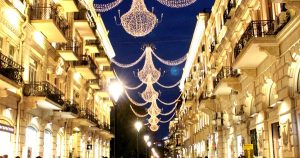Nizami Street (Azerbaijani: Nizami küçəsi) is a large pedestrian and shopping street in downtown Baku, Azerbaijan, named after classical  poet Nizami Ganjavi.
poet Nizami Ganjavi.
The street’s history could be traced back to Baku’s town-planning project of 1864. The street runs through the city’s downtown from west to east. It begins from Abdulla Shaig Street, in mountainous part of the city and ends at railroad bed on Sabit Orujov Street, near a monument to Shah Ismail Khatai in “Black City”. Total length of the street is 3,538 m.
The traffic-free segment, which begins at the Fountains Square and ends at the Rashid Behbudov Street, is commonly known as Torgovaya (“the merchant street” in Russian).
Nizami Street is home to various outlets, from banks to fashion stores and is one of the most expensive streets in the world. The street also accommodates the embassies of Germany, Norway, the Netherlands and Austria, as well as the European Union Delegation to Azerbaijan. The nearest metro stations are Sahil (red line, south of Nizami Street) and 28 May (both red and green lines, north of the street).
accommodates the embassies of Germany, Norway, the Netherlands and Austria, as well as the European Union Delegation to Azerbaijan. The nearest metro stations are Sahil (red line, south of Nizami Street) and 28 May (both red and green lines, north of the street).
Architecture of the street reflects a synthesis of various styles and directions, which is because, the intensive construction and building was realized in three main levels: late 19th-early 20th century, 1950s-1970s and a modern period.
Most of the buildings, constructed in the first level, were constructed in “neo-renaissance”, “neo-gothic”, “baroque” and “neoclassicism” styles as other buildings of the city constructed in that period. “Neo-Moorish” style also dominates, in which architects attempted to use elements of national architecture in its construction. Houses are dressed with limestone – aglay. The first level could be divided into three  territories of construction: the first – between Vorontsov Street (now Islam Safarli Street) and Persian Street (now M.Muktarov Street), where were located the most ancient buildings constructed by the projects of N.A.von der Nonne and M.Gafar Ismayilov, the second – from a territory, adjoined from Taza Pir Mosque to the South which was a complex of one and two storeyed buildings, the third to the side of railway station, and namely in the third zone, at the turn of the 19th century-beginning of the 20th century, began to be constructed more significant three and four storeyed buildings by the projects of Jozef Ploshko and I.V.Goslavski.
territories of construction: the first – between Vorontsov Street (now Islam Safarli Street) and Persian Street (now M.Muktarov Street), where were located the most ancient buildings constructed by the projects of N.A.von der Nonne and M.Gafar Ismayilov, the second – from a territory, adjoined from Taza Pir Mosque to the South which was a complex of one and two storeyed buildings, the third to the side of railway station, and namely in the third zone, at the turn of the 19th century-beginning of the 20th century, began to be constructed more significant three and four storeyed buildings by the projects of Jozef Ploshko and I.V.Goslavski.
The second level of the architectural development of the street is connected to intrusion of new buildings in the middle of the 20th century, which were implemented in “empire” or so called “Stalin’s empire” style. Later, in the end of 1950’s were constructed residential houses, many of which were projected and constructed in a new artistic architectural style which was widely spread in a lot countries of the world and which was known as “constructivism”. According to art critics H.F.Mammadov, architectural style of constructivism was shown fully and manifold almost in Baku in the whole USSR, where it was used for giving the city a new character. Enthusiasm for constructivism in Baku resulted in the creation of a local variety – “constructivism of Baku”. As in earlier constructions, the architects introduced eastern and national tints, which are especially felt in implementation of arches and monograms of the buildings, which significantly changes the total stylistic appearance of these buildings and façade of the building is dressed with aglay.
which were implemented in “empire” or so called “Stalin’s empire” style. Later, in the end of 1950’s were constructed residential houses, many of which were projected and constructed in a new artistic architectural style which was widely spread in a lot countries of the world and which was known as “constructivism”. According to art critics H.F.Mammadov, architectural style of constructivism was shown fully and manifold almost in Baku in the whole USSR, where it was used for giving the city a new character. Enthusiasm for constructivism in Baku resulted in the creation of a local variety – “constructivism of Baku”. As in earlier constructions, the architects introduced eastern and national tints, which are especially felt in implementation of arches and monograms of the buildings, which significantly changes the total stylistic appearance of these buildings and façade of the building is dressed with aglay.



1 Comment
Here is beautiful,especially at nights.I love Baku !